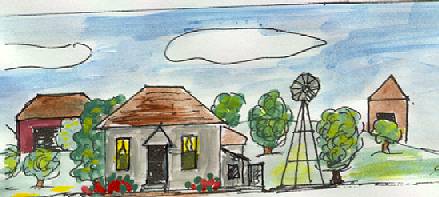 Lois made curtains and hung them at the windows. She put pictures on the walls and made the little house into a home. The next spring she planted a garden and flowers. Now it was home.
Lois made curtains and hung them at the windows. She put pictures on the walls and made the little house into a home. The next spring she planted a garden and flowers. Now it was home.
Around the year of 1900 a family came to Iowa in a covered wagon and pulled it onto a wooded section of land north and east of Hedrick. They parked under oak trees and liked it so much they bought the land. The men cut trees and pulled them to a sawmill down by the river. They used flat rocks for a foundation and started building a house.
The family lived in that covered wagon and cooked outdoors. The father and sons slept on the ground. They plowed the ground for a garden and planted corn and oats. They started to build a house and had it done by fall. The family moved from their covered wagon into the house. Nuts were gathered in the woods, a cellar was dug for vegetables and they hunted for meat.
Years later the owners died and the property was sold.
During the depression two young men came to the house looking for work. They cut trees and the lumber was sold to pay bills. They built a dugout in the timber to live in. There was room for a stove, table and two small beds made of trees and straw mattresses. Years later that old dugout could still be seen back in the timber.
In the fall of 1948 while I was living with my sister, Lois and brother-in-law, Ray, the farm they were renting sold and that meant we had to move. Farms were scarce and Ray looked everywhere trying to find another one to rent but there was nothing available. Finally he found a farm on land north and east of Hedrick that belonged to a Mr. Hawthorne. There was an old empty house on the land. It was the house that was built by those early pioneers in 1900.
Lois and I were dismayed. The house had been empty for awhile. It had four rooms and a path. The roof needed patching; there was no water in the house and no electricity. But because there was nothing else available at that time we moved in on a depressing, cold, wet, fall day. The house sat on a dirt road so we soon learned how fast that dirt turned to mud. We finished moving and getting things put away. I had used an outhouse before but now I learned more about how pioneers lived. Our lights were Coleman lanterns and we ironed clothes with a sad iron or a gas iron.
 Lois made curtains and hung them at the windows. She put pictures on the walls and made the little house into a home. The next spring she planted a garden and flowers. Now it was home.
Lois made curtains and hung them at the windows. She put pictures on the walls and made the little house into a home. The next spring she planted a garden and flowers. Now it was home.
I can still remember how we celebrated when electricity came to the house and it seemed as bright as day after those old lanterns. The road was graveled so it would be passable in springtime mud.
I lived with Lois and Ray and Jimmy in that house for two years and it was always home to me. When Mr. Hawthorne died they became the owners of the farm. Lois and Ray had four daughters after I left. The kids delighted in exploring the timber and looking through the old dugout built by the young men in the depression years. They lived in that house until 1963 when they bought a farm down the road and had a bigger home.
The old house had given them many happy hours and as they drove away Lois said that it looked sad and lonely. There was a light rain falling and the empty windows looked as though they were shedding tears.
As the years went by the windows in the old house were broken; the doors were kicked in by prowlers. Ray decided to tear down the little house. He knocked off boards one by one. He would use the boards for another building. The little house would be gone, but it would live again in another building.
Houses are like people. My brother-in-law, Ray grew old and his body wore out. Like the little house, he's gone now but I know that someday we will see him in a new home.
| Home | A Time to Remember |